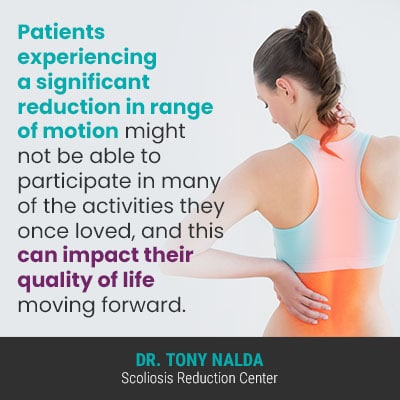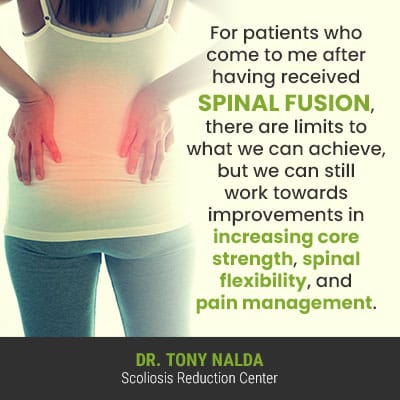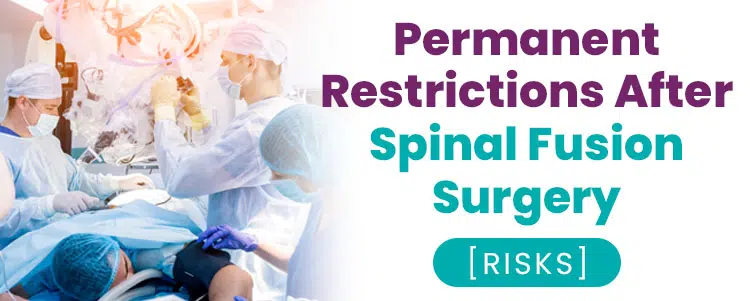There are two main scoliosis treatment approaches: traditional and conservative; it’s important to understand how they differ as they can offer patients contrasting results that impact the quality of life. Spinal fusion fuses spinal vertebrae with the goal of preventing progression, but it can come with some heavy potential side effects and restrictions, and there are less-invasive treatment options that should be considered first.
Spinal fusion surgery is a traditional scoliosis treatment option, but there are other options that carry fewer risks. While it can successfully prevent further progression, fusing the spine can come at the expense of its overall health and function, particularly in terms of the range of motion.
Let’s start our discussion on spinal fusion surgery risks and restrictions by first discussing some important condition characteristics.
Understanding Scoliosis
Being diagnosed with scoliosis means there is an unnatural sideways spinal curvature, with rotation and a minimum Cobb angle measurement of 10 degrees.
If the above parameters have been met, a diagnosis of scoliosis is given, which includes comprehensively assessing the condition and classifying it on its severity scale of mild, moderate, severe, and very severe.
So as you can see, scoliosis develops across a large severity spectrum. As a progressive condition, this means it will get worse over time, especially if left untreated or not treated proactively.
As scoliosis progresses, the unnatural spinal curve increases in size, and symptoms like postural changes and pain (more common in adults) tend to also increase.
In addition, as a scoliotic curve is getting larger, it becomes more rigid, causing pain, a loss in spinal flexibility, strained muscles, and making the spine less responsive to treatment. This is why early detection, while not guaranteeing successful treatment results, does increase the likelihood of treatment success.
Scoliosis doesn’t just range widely in severity, but also in curvature location, as well as different condition types with varying underlying causes.
The most prevalent type of scoliosis is adolescent idiopathic scoliosis (AIS), diagnosed between the ages of 10 and 18. Idiopathic means we don’t fully understand what causes this condition type to develop; as this is the most prevalent form, we’ll focus on this type for our current purposes.
In addition, as growth and development is the condition’s main cause of progression, this age group is at risk for rapid-phase progression.
While scoliosis is most commonly diagnosed in children and adolescents, it does affect all ages, the two most prevalent forms diagnosed in adults being idiopathic and degenerative.
So if an adolescent is diagnosed with scoliosis, what comes next?
Scoliosis Treatment Options
As mentioned, the two main scoliosis treatment options to choose between are traditional and conservative: the former funnels patients towards spinal fusion surgery, while the latter uses proactive treatment to non surgically treat the condition and avoid reaching the point of progression where scoliosis surgery is recommended.
Under a traditional approach, an adolescent would follow this path of treatment; they would likely be taken in to see their family general practitioner who, keep in mind, is not a scoliosis specialist, will conduct a physical exam and assess if the adolescent has indicators of scoliosis that warrant further testing.
Should indicators be present, the young patient would likely be sent for an X-ray; if the X-ray does show scoliosis, the patient is given a diagnosis, and this is where there is a fork in the road of treatment.
The most important decision to make after receiving a scoliosis diagnosis is how to treat it moving forward, and remember, as a progressive condition, without treatment, it’s virtually guaranteed to get worse, particularly for young patients who have a lot of growth to go through.
In most cases of a diagnosis given by a general practitioner, unless asked to be referred to a scoliosis chiropractor, the referral would be sent to a spinal surgeon who, while an expert in spinal fusion, isn’t an expert in nonsurgical treatment options.
If the young patient is in the mild stage of progression, they are told to return for periodic checkups to monitor for progression, but in between visits, the patient can have a large growth spurt and experience significant progression because the curvature wasn’t proactively treated while still mild. The watch and wait period feels like wasting valuable treatment time.
Other than traditional scoliosis bracing in for moderate cases, which is known to have its shortfalls, patients aren’t actively treated until they progress into the severe level and receive a surgical recommendation.
After spinal fusion surgery, patients may wonder about permanent restrictions, particularly when dealing with conditions like straight back syndrome, as understanding the limitations and lifestyle adjustments post-surgery is crucial for a successful and timely recovery.
This is why it’s so important for patients, and their families, to educate themselves on all treatment options available to them, or they can find themselves funneled down a certain path with no awareness there is another way.
What is Spinal Fusion?
While surgeons have their patients’ best interests at heart, spinal fusion is a lengthy, costly, and invasive procedure, and just as any surgery comes with its share of risks, spinal surgery is no exception.
The process of spinal fusion involves fusing together the most-tilted vertebrae at the apex of the curve; this is done to eliminate movement (progression) in the area, and while there are different types of spinal fusion involving different techniques, the spine is commonly held in place with rods and screws while the spine continues to fuse.
The hardware is not removed, so this is a factor to consider with spinal fusion; if the patient has an adverse reaction to the hardware used, or the hardware fails, the only recourse is subsequent surgeries.
While spinal fusion can achieve its goal of preventing further progression, there are no guarantees, and while many adolescents get spinal surgery for cosmetic reasons, surgery can’t fully return a body to its pre-scoliosis state, and many patients are disappointed with the cosmetic results.
Some of the most common risks associated with the surgery itself include:
- Nerve damage
- Infection
- Excessive blood loss
- Painful fusion site
- Need for subsequent surgeries
While the surgical risks are considerate, what I really want patients to be aware of when deciding on treatment, is that life after the surgery can have some unexpected challenges.
Some of the most common post-surgical side effects and risks include:
- Increased pain
- Neurological damage
- Loss of spinal flexibility and range of motion
- Adverse reaction to hardware
- Hardware failure/deterioration over time
- Continued progression
- Disappointing cosmetic results
- Negative psychological impact of living with a fused spine
As every case is different, surgical outcomes will vary based on a number of important patient/condition variables: patient age and overall health, whether or not there were complications during surgery, condition severity, fusion site, and the number of vertebrae involved.
In general, the more vertebrae that are fused together, the more likely the patient is to experience some of the above side effects.
Perhaps the most common scoliosis surgery side effect, and the most disappointing for many, is the loss in spinal flexibility and range of motion; many post-surgical patients experience a significant loss in spinal flexibility, and this can lead to certain activity restrictions.

Patients experiencing a significant reduction in range of motion might not be able to participate in many of the activities they once loved, and this can impact their quality of life moving forward.
In addition, a fused spine is far more prone to injury as it’s less able to absorb and distribute shock from impact, and this knowledge can have a very real psychological impact as patients can become fearful of trying new things.
In addition, a rigid spine causes pain, and a spine with less flexibility is not able to function optimally, putting more strain on surrounding muscles as they struggle to support it, which can lead to tight/sore/strained muscles, and pain related to that.
When it comes to the permanent restrictions of cervical fusion, every patient’s body responds to surgery differently, but generally, it’s a loss of flexibility in the neck area, strained neck muscles, and related pain and stiffness in the area, which can also cause tension headaches.
When it comes to permanent restrictions after lumbar spinal fusion, we’re talking about the spinal section that has to support the majority of the spine and trunk’s weight, and the lumbar spine, as it’s connected to the pelvis, has a lot to do with the range of motion of the trunk and lower body.
Lumbar spinal fusion can result in lower back pain, and difficulty with bending and twisting motions, and this can restrict certain activities that involve repeated bends and trunk rotation.
After undergoing a spinal surgery, patients may face the possibility of permanent restrictions, depending on the specific procedure and their unique medical circumstances. For instance, in the case of an Anterior Cervical Discectomy and Fusion (ACDF) surgery, there might be permanent restrictions, especially when it comes to lifting heavy objects, as this surgical procedure aims to provide spinal stability in the neck region, addressing neck pain and related issues.
Similarly, spinal fusion procedures, whether in the lumbar region or involving two or more vertebrae, may lead to lasting limitations on certain activities, including lifting. In contrast, a laminectomy, which is often performed to relieve pressure on the spinal cord or nerves, may result in its own set of permanent restrictions based on the patient’s condition and the intricacies of the surgical procedure. The key lies in understanding the specifics of each case and following the medical advice provided to ensure a smooth post-operative recovery and long-term spinal health.
Patients who undergo spinal fusion surgery with a Harrington Rod may wonder about the potential permanent restrictions and risks associated with this procedure while seeking the best treatment for scoliosis.
Let’s also address a common post-surgical question:
What Happens if I Bend After Spinal Fusion?
Again, while each case is different with varying degrees of spinal-flexibility loss, most people can bend after spinal fusion. It’s just a matter of how far they can bend, but bending in the immediate days following surgery is a restriction.
After spinal fusion, a patient’s spine has to heal, and they have to do so without straining it. Especially the fusion site, so many motions such as bending and twisting are restricted until the fusion site has fully healed. Patients are cleared for such movements/activities by their care provider.
Fortunately, there is a conservative treatment approach that has achieved impressive results, helping many avoid the need for invasive surgery.
Conservative Scoliosis Treatment Approach and the Scoliosis Reduction Center®
Here at the Scoliosis Reduction Center®, I offer patients a conservative chiropractic-centered treatment approach that strives to preserve the spine’s overall health and function throughout treatment and beyond.
While spinal surgery has its place in the treatment of scoliosis, there are other options for reducing a surgical-level curve, and while it’s not a quick fix, the results we’ve achieved have helped many patients achieve a better quality of life.

For patients who come to me after having received spinal fusion, there are limits to what we can achieve, but we can still work towards improvements in increasing core strength, spinal flexibility, and pain management.
Here at the Center, I believe in proactive treatment initiated as close to the time of diagnosis as possible, so my ultimate goal is to help patients avoid the hardships of increasing condition severity and the need for invasive treatment in the future.
Unlike the traditional approach, I see a case of mild scoliosis as an opportunity to keep it that way, not as the time to watch and wait; as a progressive condition, where a patient’s scoliosis is at the time of diagnosis is not indicative of where it will stay.
By combining multiple treatment disciplines such as condition-specific chiropractic care, in-office therapy, custom-prescribed home exercises, and corrective bracing, I can help patients reduce their surgical-size curve, increase core strength so the spine can be optimally supported and stabilized by its surrounding muscles, and augment corrective results with corrective bracing that pushes the spine into a corrective position.
As this type of treatment doesn’t involve squeezing the spine unnaturally or artificially holding it in place through the use of hardware, it focuses on correction rather than solely stopping progression, and when the spine’s natural function is preserved, this means living with fewer restrictions.
Through proactive treatment that focuses on preserving as much of the spine’s natural function as possible, for those who choose to forego a surgical recommendation or simply want to try a less-invasive option first, there is a nonsurgical treatment option available can offer impressive results.
Conclusion
Just as each and every patient has different condition characteristics, everyone will respond to treatment differently, surgery included.
What I want every patient to be aware of is that there are different treatment options available to them.
It’s important that patients’ treatment expectations are aligned with the reality of their potential outcomes as, unfortunately, when patients are funneled in a certain direction, without awareness of other options, this can lead to disappointing results.
While no form of scoliosis treatment can guarantee results, when it comes to permanent restrictions after spinal fusion surgery, if successful at stopping progression, we’re still talking about a spine that’s held in place by artificial means, and there is also a gap in the research on long-term effects of living with a fused spine, not to mention hardware longevity.
Many post-surgical patients come to me disappointed with the cosmetic results, an increase in back pain, and a reduced range of motion. These are risks that all patients should be aware of before committing to the procedure.
Here at the Scoliosis Reduction Center®, I offer patients a less-invasive treatment option that can work towards achieving corrective results through a curvature reduction, increasing core strength, and corrective bracing.
For those looking for support and guidance on the different treatment options available and the risks associated with each, don’t hesitate to reach out to us so we can discuss our approach to treating surgical-level curves, as well as how our proactive treatment can help avoid progressing to the point of a surgical recommendation altogether.




